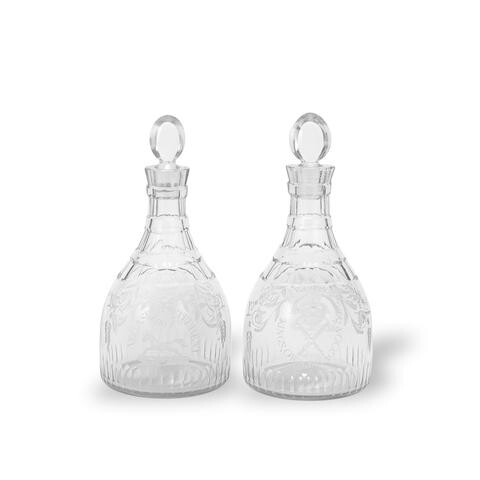A fine pair of Regimental cut and engraved glass decanters and stoppers, circa 1800
Of broad-based taper form, one side with a crossed sword and sceptre beneath a crown within the inscription 'KINGS.OWN.DRAGOONS', all beneath scrolling foliage, the other with the galloping White Horse beneath the motto 'NEC,ASPERA,TRRENT' and further scrolling foliage, the neck cut with three rings alternating with four rows of facets, a band of short flutes around the base, the flattened lozenge-shaped stoppers chamfered at the edges, 27cm high (4)
The introduction of firearms prompted the formation of Regiments armed and equipped as infantry, but mounted on small horses for expedition of movement, which were styled 'Dragoons'. The Third (The King's Own) Regiment of Dragoons was formed in 1685. Originally known as The Queen Consort's Own Regiment of Dragoons, they became The King's Own Regiment of Dragoons in 1714. They were styled The Third (The King's Own) Dragoons between 1751 and 1818, during which time they served with distinction in the Peninsular War and during the Waterloo Campaign between 1811 and 1814. The regiment subsequently bore the words 'Salamanca', 'Vitoria', 'Toulouse' and 'Peninsula' on its appointments, commemorating its Gallant Conduct in Spain and France, alongside the White Horse and its motto 'Nec Aspera Terrent' (Difficulties be Damned).
The Regiment embarked England to serve in the Napoleonic Wars on 25 July 1811, landing in Lisbon that August to serve in the Peninsular War. It took part in the Siege of Ciudad Rodrigo in January 1812 and the Siege of Badajoz in March 1812, before undertaking successful charges at the Battle of Villagarcia in April 1812 and at the Battle of Salamanca in July 1812. It subsequently took part in the Battle of Vitoria in June 1813 and, having pursued the French Army into France, at the Battle of Toulouse in April 1814. On 19 July 1814 the Regiment embarked at Boulogne and arrived at Dover the following day, having been absent for three years. Immediately following the victory at Waterloo in 1815, the Regiment left England once more to form part of the Army of Occupation in France following the restoration of Louis XVIII. It returned home in October 1818, following which it became The Third (The King's Own) Regiment of Light Dragoons. It was subsequently known as The Third (The King's Own) Hussars from 1861, before being amalgamated into the Queen's Own Hussars in 1958. William Cartwright (1754-1827) held the colonelcy from 28 November 1807 until 1821, and it is conceivable that this pair of decanters was made for him.
View it on
Estimate
Time, Location
Auction House
Of broad-based taper form, one side with a crossed sword and sceptre beneath a crown within the inscription 'KINGS.OWN.DRAGOONS', all beneath scrolling foliage, the other with the galloping White Horse beneath the motto 'NEC,ASPERA,TRRENT' and further scrolling foliage, the neck cut with three rings alternating with four rows of facets, a band of short flutes around the base, the flattened lozenge-shaped stoppers chamfered at the edges, 27cm high (4)
The introduction of firearms prompted the formation of Regiments armed and equipped as infantry, but mounted on small horses for expedition of movement, which were styled 'Dragoons'. The Third (The King's Own) Regiment of Dragoons was formed in 1685. Originally known as The Queen Consort's Own Regiment of Dragoons, they became The King's Own Regiment of Dragoons in 1714. They were styled The Third (The King's Own) Dragoons between 1751 and 1818, during which time they served with distinction in the Peninsular War and during the Waterloo Campaign between 1811 and 1814. The regiment subsequently bore the words 'Salamanca', 'Vitoria', 'Toulouse' and 'Peninsula' on its appointments, commemorating its Gallant Conduct in Spain and France, alongside the White Horse and its motto 'Nec Aspera Terrent' (Difficulties be Damned).
The Regiment embarked England to serve in the Napoleonic Wars on 25 July 1811, landing in Lisbon that August to serve in the Peninsular War. It took part in the Siege of Ciudad Rodrigo in January 1812 and the Siege of Badajoz in March 1812, before undertaking successful charges at the Battle of Villagarcia in April 1812 and at the Battle of Salamanca in July 1812. It subsequently took part in the Battle of Vitoria in June 1813 and, having pursued the French Army into France, at the Battle of Toulouse in April 1814. On 19 July 1814 the Regiment embarked at Boulogne and arrived at Dover the following day, having been absent for three years. Immediately following the victory at Waterloo in 1815, the Regiment left England once more to form part of the Army of Occupation in France following the restoration of Louis XVIII. It returned home in October 1818, following which it became The Third (The King's Own) Regiment of Light Dragoons. It was subsequently known as The Third (The King's Own) Hussars from 1861, before being amalgamated into the Queen's Own Hussars in 1958. William Cartwright (1754-1827) held the colonelcy from 28 November 1807 until 1821, and it is conceivable that this pair of decanters was made for him.



